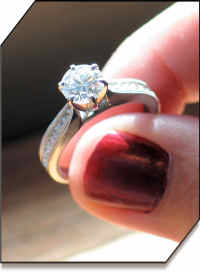 The topic of this Family Blog Article focuses upon what happens to the engagement ring in the event of a “broken engagement”. Most of the cases which are cited below provide the following information to the reader: An engagement ring is a conditional gift given in contemplation of marriage; and, therefore, an engagement ring is not an absolute gift.
The topic of this Family Blog Article focuses upon what happens to the engagement ring in the event of a “broken engagement”. Most of the cases which are cited below provide the following information to the reader: An engagement ring is a conditional gift given in contemplation of marriage; and, therefore, an engagement ring is not an absolute gift.
I will provide to the reader a synopsis of several cases in Ohio. In all scenarios below, the Donor is the male person gifting the engagement ring and the Donee is the female person receiving the engagement ring.
Scenario #1:
Facts: In August 1980, while still in college, Donor gave a diamond engagement ring to Donee. Both parties then returned to their respective colleges. The Donor was attending college in Canada and the Donee was attending college in Athens, Ohio. In May 1981, the Donor returned to Ohio and demanded the return of the engagement ring. The Donee refused to return the ring. Donor then filed a Complaint against the Donee for the return of the engagement ring, or in the alternative, damages in the amount of $2,000.
The case cited the general principle of law: The donor of an engagement ring can recover the gift only if the engagement is dissolved by agreement or if it is unjustifiably broken by the donee. The Court noted the parties agreed that the ring was given in contemplation of marriage and that it was a “conditional gift”. The Plaintiff/Donor also argued the engagement ring was a family heirloom and, as such, that it should be returned to the Donor. Interestingly, the Court found that the Plaintiff/Donor’s Mother and Father knew that the ring was going to be “gifted” to the Donee and that neither Mother, nor Father, placed any conditions upon the return of the ring if the marriage did not take place.
Outcome: The Court ruled in favor of the Defendant/Donee as the Plaintiff/Donor failed to establish that Defendant/Donee caused the break up of the engagement or that the engagement was broken by agreement of the parties.
Coconis v. Christakos (November 24, 1981), 70 Ohio Misc. 29.
Scenario #2:
Facts: In August 1980, Donor and Donee agreed to be engaged and they purchased an engagement ring and matching wedding band from a jeweler. Donor paid $1700 for the rings and the Donee paid an additional $50 at the time that she picked up the rings from the jeweler. Donee began to wear the engagement ring and the Donor held possession of the wedding band. In January 1981, Donor broke the engagement with the Donee, but the parties continued to see one another until August 1981. It was later revealed that Donee, in anger, took the wedding band from Donor’s residence after he had broken the engagement. When Donor discovered the wedding band was missing from his residence, he demanded in writing that both rings be returned to him. The Donee refused to return the rings to him.
In November 1981, Donee became engaged to another party. Donee and her new fiancé took the engagement ring and wedding band to a jeweler and used them as a “trade in” for a new set of rings. In her depositions, Donee stated that Donor had told her on more than one occasion that she could keep the rings.
The trial court ruled in favor of the Plaintiff/Donor granting his Motion for Summary Judgment against the Defendant/Donee. The Defendant/Donee then appealed the decision of the trial court and the Court of Appeals ordered it back to the trial court. The issue of whether or not the Plaintiff/Donor told the Defendant/Donee that she could keep the rings had to be decided by the trial court.
Lyle v. Durham (February 15, 1984), 16 Ohio App. 3d.
Scenario #3:
Facts: In May 2001, Donor was seriously injured in an automobile accident resulting in a lengthy hospitalization. While he was in the hospital, he was visited by Donee and her mother. A romantic relationship developed and Donor proposed to Donee. However, at the time that Donor proposed, Donee was married to another man. Donor was then awarded a personal injury settlement of $180,000 from the automobile accident and, subsequently, purchased an engagement ring for Donee and a gift for her mother because he thought they would be living in the mother’s home after their marriage.
In July 2002, there was a disagreement between Donor and Donee’s mother and Donor moved out of the home. Donor and Donee were not yet married, but they remained engaged. However, when Donor confided to Donee that he planned to sue her mother for monies expended on her behalf, Donee said she would have to break the engagement. Donor then filed a Complaint against Donee and her mother to have the gifts returned to him. The trial court dismissed Plaintiff/Donor’s Complaint and he appealed it to the Court of Appeals.
The Court of Appeals said that gifts in contemplation of marriage become problematic if the marriage does not occur. The Court found that there were five (5) approaches to be taken in resolving these matters:
Approach #1: The Donor is denied recovery of the gift (engagement ring) if the Donee was legally married to someone else. This approach recognizes that an agreement to marry when one party is already married is against public policy.
Approach #2: This approach treats all gifts exchanged during the engagement period as irrevocable gifts unless the gifts are expressly conditioned upon the subsequent marriage.
Approach #3: This approach treats the engagement ring as a conditional gift but treats all other gifts as being irrevocable gifts. The Court noted that this approach recognizes that the engagement ring symbolizes the couple’s intent to marry. Ultimately, the Court held that this approach is the best approach in matters regarding the return or retention of an engagement ring.
Approach #4: This is a “fault based” approach and permits the Donor to recover the engagement ring if the Donee caused the break up of the engagement. This approach used to be the general principle of law in Ohio.
Approach #5: This is the “No Fault Approach”. In this approach, an engagement ring would be returned to the Donor if the marriage does not take place. This approach is used most often by Ohio courts. See, Cooper v. Smith (November 7, 2003), 155 Ohio App.3d 218.
In light of the five (5) different approaches as set forth above, what is the safest course to take? Reduce the parties’ agreement to writing with signatures from each party. The parties could acknowledge and accept the fact that the engagement ring is a “conditional gift” and, if the engagement were to be broken by either party, the engagement ring would be returned to the Donor. Also, if the engagement ring is a family heirloom that has been handed down for one or more generations, it is even more important to have a written agreement. By not having a written agreement, the Donors and Donees risk having their “dilemma” decided by the Courts who may not have sympathy for either party to a broken engagement!
© 2011, Ohio Family Law Blog. All rights reserved.

Anne Shale is of counsel to Dayton, Ohio, law firm, Holzfaster, Cecil, McKnight & Mues. She is a former registered nurse and concentrates her practice in Family Law and Divorce cases.


